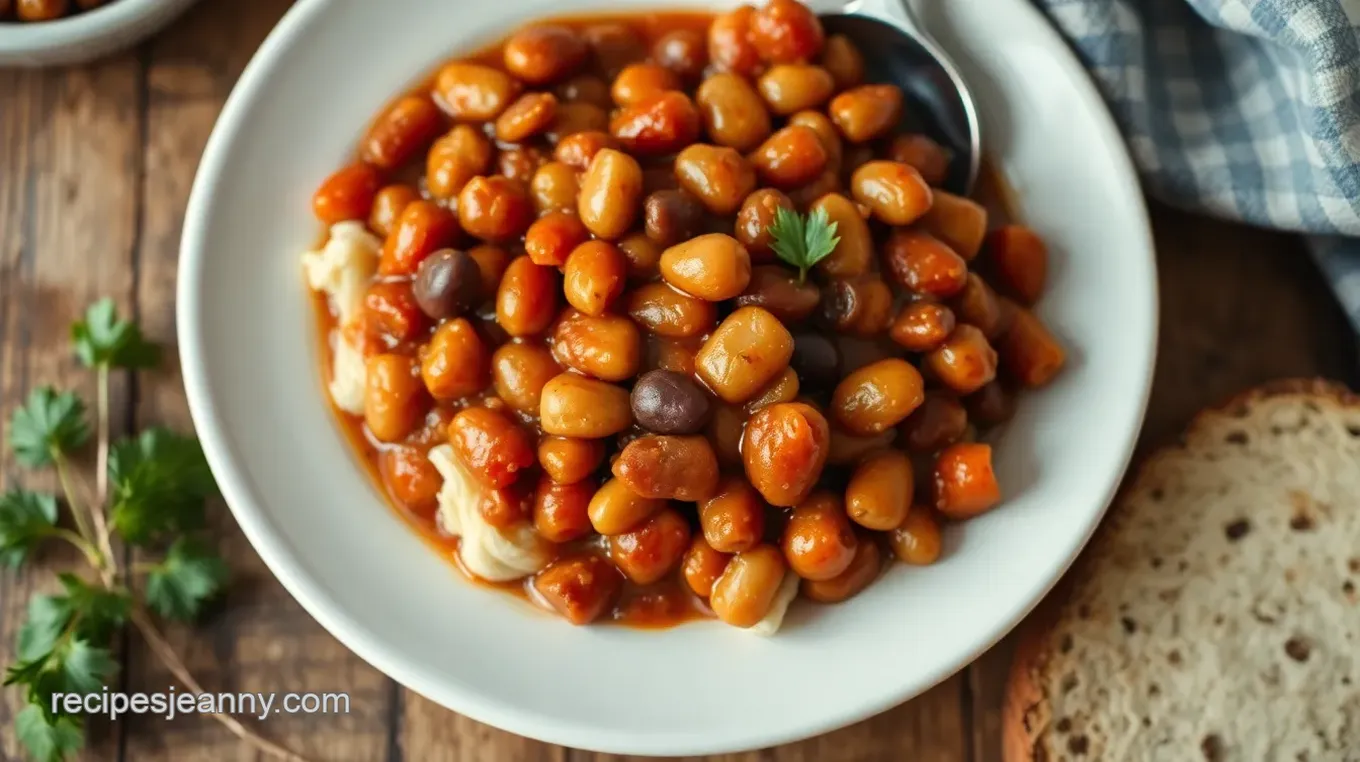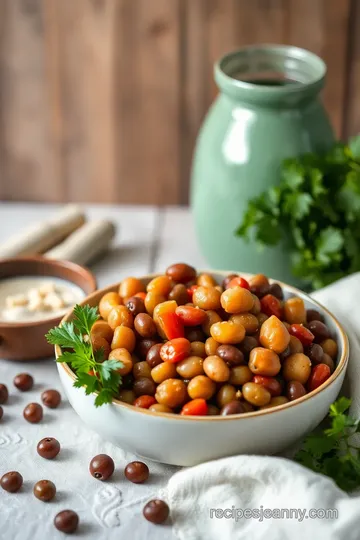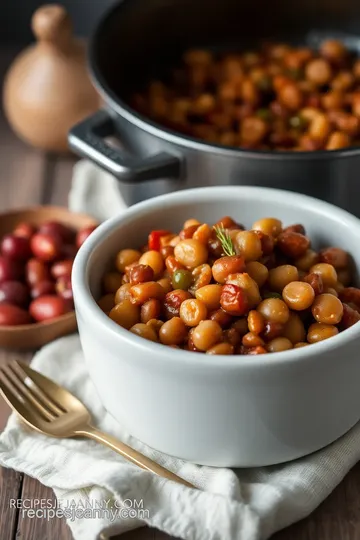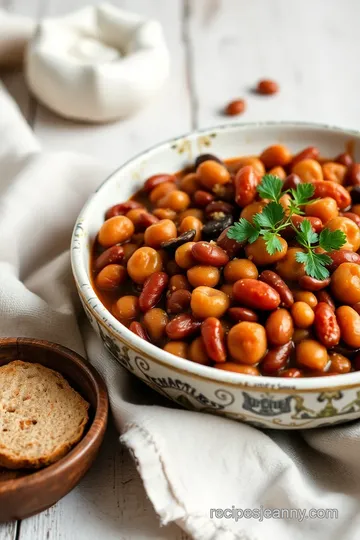Slow Cooked Mixed Legumes with Hearty Flavor
Craving a hearty meal? My Slow Cooked Mixed Legumes with Hearty Flavor is packed with fiber and plant-based protein. Perfect for cozy dinners or meal prep!

- Welcome to the Cozy World of Legumes
- A Hearty Dish with a Rich Backstory
- Why You’ll Love This Dish
- Nutritional Highlights and Practicality
- Your Go-To Essential Ingredients Guide
- Professional Cooking Method for Slow Cooked Mixed Legumes with Hearty Flavor
- Additional Recipe Information: Slow Cooked Mixed Legumes with Hearty Flavor
- Frequently Asked Questions
- Recipe Card
Welcome to the Cozy World of Legumes
Have you ever had one of those days where you just need something warm and comforting? you know, when the weather’s a little dreary, and you wish you could wrap yourself in a blanket and hug a bowl of comfort food.
Well, let me tell you about my go-to dish for those moments: slow cooked mixed legumes with hearty flavor . this dish has become a staple in my kitchen, and honestly, i could talk about it for hours! but let's keep it casual and dive into why it's so special.
A Hearty Dish with a Rich Backstory
The roots of mixed legumes go way back to rustic cooking methods. cultures worldwide have cooked up comforting bean dishes with whatever they had on hand.
Over time, these hearty legume dishes evolved, blending diverse flavors and techniques. today, slow-cooked mixed bean stew has garnered a huge fanbase thanks to its cozy vibes, nutrition-packed goodness, and impressive versatility.
Plus, who doesn’t love a meal that can simmer away while you binge-watch your favorite show?
This recipe is pretty approachable too. with just 15 minutes of prep time , you’ll have a vibrant medley of beans and lentils simmering in your slow cooker, leaving you free to conquer the rest of your day.
And if you’re worried about cost, fret not! this easy legume recipe won’t break the bank. you’ll yield enough for 6-8 servings , making it perfect for family dinners or meal prep for the week.
Why You’ll Love This Dish
Let’s talk benefits. first off, this dish is a nutritional powerhouse ! packed with plant-based protein and fiber , these legumes make for a seriously filling meal.
You’ll feel satisfied, not stuffed. it’s like they are giving you a big, warm hug with every bite.
Slow cooker comfort food is simplicity at its finest. throw everything in, go about your day, and come back to a meal that warms up your soul.
Whether it’s a laid-back weeknight or a festive gathering, this dish shines brightly. plus, it’s an amazing option for those looking to serve up vegan hearty meals or cozy vegetarian recipes .
Say goodbye to boring dinners! this dish can be dressed up or down. add a dollop of plain yogurt, sprinkle fresh herbs, or throw in some crusty bread for a rustic flair.
It’s versatile—the world is your oyster, or in this case, your legume!
Nutritional Highlights and Practicality
Let’s touch on some health benefits. each bowl contains fiber-rich goodness , which is great for digestive health. plus, it’s a gluten-free option that fits well in many diets.
Ideal for those on the plant-based journey , you can serve it alongside a fresh mediterranean bean salad, or use it as a filling side dish.
You get all these perks while keeping it simple. it’s a filling vegetarian recipe that takes almost zero effort. whether you’re feeding a hungry crew or just meal prepping for the week, these high-fiber recipes will have everyone raving.
And with the dried beans cooking tips included, you can customize this dish to your heart's content.
So, are you ready to mix up some legumes? Let’s jump into the ingredients you’ll need to create this delightful rustic bean recipe . Grab your slow cooker and let’s get cookin’!

Your Go-To Essential Ingredients Guide
Alright, let’s get real. if you're diving into cooking, especially something like my slow cooked mixed legumes with hearty flavor , you gotta have the right ingredients lined up.
Trust me, proper ingredients are the backbone of a satisfying meal. so, let's break it down.
Premium Core Components
First off, measurements. you’ve got your us and metric folk; let’s keep everyone happy, yeah? think of 1 cup of dried black beans magically translating to 200 grams .
That's the beauty of knowing both!
Now, onto quality indicators . when you’re at the store, check those beans. they shouldn’t be cracked or have any funky smells.
Freshness is key, folks. storage guidelines ? keep your dried legumes in a cool, dark place and they’ll last, like, forever—up to two years! but once you open them? you got about a year.
For picking the best ingredients, check the color and texture. Scruffy beans? Pass. Beautiful, shiny legumes? Heck yes!
Signature Seasoning Blend
Now, let’s talk seasoning . you can't make a good meal without the right spice game. for my slow cooker recipe, herbs and spices for legumes are crucial.
A classic combo? cumin, smoked paprika, and just a pinch of salt and pepper.
Herbs like cilantro and parsley elevate the flavors too. the beauty of cooking with legumes is that you can always mix in flavors from different regions.
Swap cumin for curry, and suddenly you’re working on something that feels like a warm hug from india!
Smart Substitutions
Life gets hectic, right? so, when you don’t have something on hand, don’t sweat it! there are always common alternatives .
Don’t have black beans? use pinto! and if you need a quick fix—maybe you forgot to soak those dried beans overnight—use canned chickpeas; they rock in a pinch!
Worried about dietary needs? You can adapt this to be a vegan hearty meal by swapping out any non-vegan ingredients. Couldn’t be easier!
Kitchen Equipment Essentials
Here’s the scoop on must-have tools . a reliable slow cooker is a game changer for any home cook—especially for those busy weeknights.
You don’t need fancy gear; just a cutting board and a knife that doesn’t give you blisters will do.
And what about storage solutions ? Invest in some good airtight containers. Honey, that’s where your leftovers will thrive!
Putting It All Together
So, whether you're making a cozy mixed bean stew or trying your hand at healthy slow cooker recipes , having an arsenal of quality ingredients makes all the difference.
Plus, the prep is super chill; just throw it all in the crockpot and let the magic happen.
Speaking of magic, once you gather all the nutritious legumes and get your spices sorted, we’re ready to dive into the actual cooking part! stay tuned for my step-by-step instructions that will guide you through creating that fiber-rich meal you crave.
Eating these satisfying bean dishes has never been easier or more delicious!
Let’s get cooking, friend!

Professional Cooking Method for Slow Cooked Mixed Legumes with Hearty Flavor
If you’re diving into the wonderful world of slow cooked mixed legumes with hearty flavor , you’re in for a real treat! this humble dish, packed with plant-based protein and fiber, feels like a warm hug on a chilly day.
Plus, it’s super simple to whip up. let's break down the essential preparation steps before we get to the nitty-gritty of cooking it to perfection.
Essential Preparation Steps
Let’s start with mise en place , that fancy term for having everything ready before you cook. seriously, it makes life easier! chop your veggies, rinse those beans, and have your spices lined up.
Trust me, it’ll save you from the last-minute chaos when you’re in the zone.
Next up, time management is key. you’ll want to allocate about 15 minutes for prep and then let your slow cooker do its magic for 6- 8 hours on low or 3- 4 hours on high .
I usually set my slow cooker in the morning and forget about it until dinner. pure bliss!
Organization is super important too. use your cutting board for all your chopping, and keep things tidy. a messy kitchen can be a huge distraction! oh, and don’t forget about safety - turn off your slow cooker when not in use, and make sure to wash your hands after handling raw legumes.
We all want a delicious meal without a side of foodborne illness, right?
Step-by-Step Process
-
Prepare Legumes: Rinse and sort through your legumes. Check for any stray pebbles. I’ve made that mistake before - it’s no fun chomping down on a rock.
-
Sauté aromatics: in a pan, heat 2 tablespoons of olive oil over medium heat. toss in a large, diced onion and cook until it’s translucent (about 5 minutes ).
Trust me, your kitchen will smell heavenly at this point!
-
Combine ingredients: get your slow cooker ready! transfer the sautéed mix into the cooker, and add your carefully rinsed legumes, 6 cups of vegetable broth , and a can of diced tomatoes .
Don’t be afraid to mix it all together.
-
Cooking process: cover the slow cooker and set it to low for 6- 8 hours or high for 3- 4 hours .
Resist the urge to peek too often - patience is key.
-
Finishing Touches: Before serving, taste it! Adjust your seasoning as needed. A sprinkle of fresh parsley or a squeeze of lemon juice elevates everything.
Expert Techniques
Here’s where it gets fun—professional cooking tips! one key point: always taste as you go. it’s like adding little love notes to your dish.
Remember, legumes should be tender but not mushy! if you notice they’re softening too quickly, lower the temperature.
And if you run into a hiccup—maybe it’s not as flavorful as you’d hoped—add some more herbs! fresh herbs like thyme or cilantro can work wonders.
Also, don't forget to check for those qualité checkpoints. when you're nearing the end of the cooking time, just poke a bean—if it splits without a fight, it’s perfect!
Success Strategies
Let’s talk about common mistakes. one major no-no? forgetting to soak your legumes overnight. it makes them softer and cuts down on cooking time.
If you’re short on time, even a quick soak for an hour in hot water helps.
For quality assurance, always have a spoon handy for taste testing. If it feels flat, maybe it just needs a pinch more salt or a dash of vinegar.
And don’t stress if you don’t finish it in one meal. this dish freezes like a champ! portion it into airtight containers for quick meals later.
It’s perfect for busy nights when you crave something hearty and satisfying without the fuss.
Transitioning to the Next Section
So there you have it, folks! a comforting slow cooker recipe that’s simple, nutritious, and oh-so-delicious. if you’re looking for more tips and variations to keep your culinary journey exciting, stay tuned for the next section: additional information .
We’ll dive into ways you can personalize this rustic bean recipe even further.

Additional Recipe Information: Slow Cooked Mixed Legumes with Hearty Flavor
Slow cooked mixed legumes with hearty flavor is more than just a dish; it’s a cozy hug in a bowl.
So, let’s dive into all the juicy details to make this recipe not just a one-time wonder but a staple in your kitchen.
From pro tips to presenting it beautifully, we’ve got you covered!
Pro Tips & Secrets
Chef's personal insights
every time i make this hearty legume dish, i realize it's about love and patience— like a good romance! so, let those beans soak overnight for that creamier texture next day.
Trust me, you'll thank me later!
Time-saving techniques
wanna speed things up? use canned legumes! a mix of canned and dried beans work like a charm, cutting your cook time down.
Just remember to reduce the broth a tad since canned beans are pre-cooked.
Flavor enhancement tips
for a flavor boost, toss in some herbs and spices for legumes —like fresh thyme or a pinch of cayenne if you’re feeling adventurous.
Seriously, a dash of good-quality olive oil as a finishing touch takes it to the next level!
Presentation advice
when serving, don’t just plop it down! ladle your delicious mixed bean stew in a bowl, add a sprinkle of fresh parsley, and maybe some lemon wedges for a pop.
Presentation is half the battle, right?
Perfect Presentation
Plating techniques
dish it up like you’re serving a five-star meal! use a deep bowl to showcase your slow-cooked comfort food .
Really, layer with beans and broth, and finish with an elegant swirl of olive oil on top.
Garnish ideas
just a few fresh herbs can transform your dish. a sprinkle of cilantro or parsley not only looks great but enhances that herbal flavor.
If you want a little zest, add those lemon wedges around the edge of the plate.
Color combinations
mixing colorful legumes and bright garnishes can turn your cozy meal into a rainbow on your table.
Greens, reds, and blacks—this dish showcases all of the beautiful colors of winter and makes me feel warm and fuzzy inside.
Visual Appeal Tips
Use contrasting bowls—think white with colorful legumes. It’s all about those first impressions! A well-presented dish can totally elevate your filling vegetarian recipes from ordinary to extraordinary.
Storage & Make-Ahead
Storage Guidelines
This dish is amazing for meal prep! Once cooled, store in airtight containers. It’s best eaten within a week, but you can freeze it for up to three months.
Preservation methods
if you have leftovers, definitely portion them out! a little goes a long way, and it’s super easy to reheat.
Just be sure to let it cool down before popping it in the fridge.
Reheating instructions
when reheating, add a splash of broth or water. it keeps the dish moist and delicious. you know how leftover slow cooker recipe can sometimes dry out– this trick saves you from that.
Freshness Duration
Generally, you can enjoy those nutritious legumes for a whole week in the fridge! The flavors keep developing and become even richer over time.
Creative Variations
Flavor Adaptations
Feeling adventurous? Change up your spices! Swap cumin and smoked paprika for curry powder if you want a quick world tour right from your kitchen.
Dietary Modifications
This is a great base for all sorts of dietary needs. Looking for vegan hearty meals ? Check! Want it gluten-free? Done! It’s versatile like that.
Seasonal Twists
Toss in seasonal veggies—like zucchini in summer or pumpkin in fall! You’ll not just enjoy a fiber-rich meal , but also get those seasonal flavors bursting!
Regional variations
try the mediterranean twist by adding olives and sun-dried tomatoes or go southern with some spicy sausage.
The world is your oyster, and your rustic cooking methods are your magic wand.
Complete Nutrition Guide
Detailed Breakdown
Each serving of this lovely stew packs a punch with about 11g of protein and 10g of fiber . Who needs meat when legumes are little nutritional powerhouses?
Health Benefits
Rich in plant-based protein, high fiber recipes like this help keep your tummy happy and full. Say bye-bye to those cravings!
Dietary Considerations
This is a naturally low-sodium dish—just keep an eye on the broth you choose. You can easily adjust for your dietary needs!
Portion Guidance
Serves 6-8, but if you’re like me, it’s hard to resist seconds. So, maybe plan for a bit more if you’re feeding your family and friends.
Encouraging Conclusion
So there you have it! with all these slow cooker comfort food tips, you’re sure to whip up a satisfying bean dish that’ll knock everyone’s socks off.
Embrace this recipe and make it your own. the world of easy legume recipes is at your fingertips, and i can’t wait for you to enjoy your slow-cooked delights! get cooking, and let that warmth fill your home.
Happy cooking!
Frequently Asked Questions
What makes the Slow Cooked Mixed Legumes with Hearty Flavor dish so nutritious?
The Slow Cooked Mixed Legumes with Hearty Flavor provides a fantastic source of plant-based protein and fiber, thanks to the variety of legumes used, including black beans, kidney beans, lentils, and chickpeas. Each serving offers a combination of essential vitamins and minerals, making it a wholesome choice for a balanced diet.
Can I use canned legumes instead of dried for this recipe?
Yes, you can use canned legumes if you're short on time! Use about 2-3 cups of canned beans and chickpeas, rinsed and drained. Keep in mind that they will need less cooking time, so add them to the slow cooker in the last hour of cooking to prevent them from becoming mushy.
What are some great variations or spices to add to the Slow Cooked Mixed Legumes with Hearty Flavor?
Variations can include adding greens like spinach during the last hour of cooking for extra nutrients or using different spices like curry powder for an Indian twist. You can also add a bay leaf for depth of flavor or diced vegetables such as carrots or zucchini to enhance the texture.
How should I store leftovers of this hearty dish?
Store leftovers in airtight containers in the refrigerator for up to 5 days or freeze for up to 3 months. Allow it to cool completely before freezing to maintain the best texture, and reheat in the microwave or on the stovetop, adding a splash of water or broth if needed to loosen it up.
Can I make Slow Cooked Mixed Legumes with Hearty Flavor spicier?
Absolutely! To add heat, consider incorporating red pepper flakes or diced jalapeños into the sautéed aromatics. Adjust the amount according to your tolerance for spice, and taste as you go, so you can achieve the perfect level for your palate.
Is there a way to adjust this recipe to make it vegetarian or vegan?
This dish is already vegan as written! Just ensure that your vegetable broth is truly vegetarian by checking the ingredients. You can also enhance the flavor by adding smoked paprika or liquid smoke for a deeper taste without using any animal products.
Slow Cooked Mixed Legumes with Hearty Flavor Card

⚖️ Ingredients:
- 1 cup (200g) dried black beans, rinsed and sorted
- 1 cup (200g) dried kidney beans, rinsed and sorted
- 1 cup (200g) dried lentils (green or brown), rinsed
- 1 cup (200g) dried chickpeas, rinsed and sorted
- 2 tablespoons (30ml) olive oil
- 1 large onion, diced
- 3 cloves garlic, minced
- 1 bell pepper (red or green), diced
- 2 teaspoons ground cumin
- 1 teaspoon smoked paprika
- 1/2 teaspoon black pepper
- 1 teaspoon salt (adjust to taste)
- 6 cups (1.5L) vegetable broth (low-sodium preferred)
- 1 (14.5 oz/410g) can diced tomatoes, undrained
- Fresh parsley or cilantro, chopped (optional)
- Lemon wedges (optional)
🥄 Instructions:
- Step 1: Rinse and sort all dried legumes, checking for debris.
- Step 2: In a pan, heat olive oil over medium heat. Add diced onion, cook until translucent. Stir in minced garlic and diced bell pepper, cook for another 2 minutes.
- Step 3: Add cumin, smoked paprika, black pepper, and salt; cook until fragrant.
- Step 4: Transfer the sautéed aromatics to the slow cooker. Add the rinsed legumes, vegetable broth, and diced tomatoes.
- Step 5: Stir the mixture well to combine. Cover and set the slow cooker to low for 6-8 hours or high for 3-4 hours.
- Step 6: Check for doneness; the legumes should be tender but not falling apart.
- Step 7: Taste and adjust seasoning if necessary. Garnish with chopped parsley or cilantro and serve with lemon wedges.
Previous Recipe: Easy Fermenting Fenugreek Seeds for Gut Health: Boost Your Digestive Wellness
Next Recipe: Decadent Bake Nutella Rolls: Soft & Delicious Treats for Breakfast
